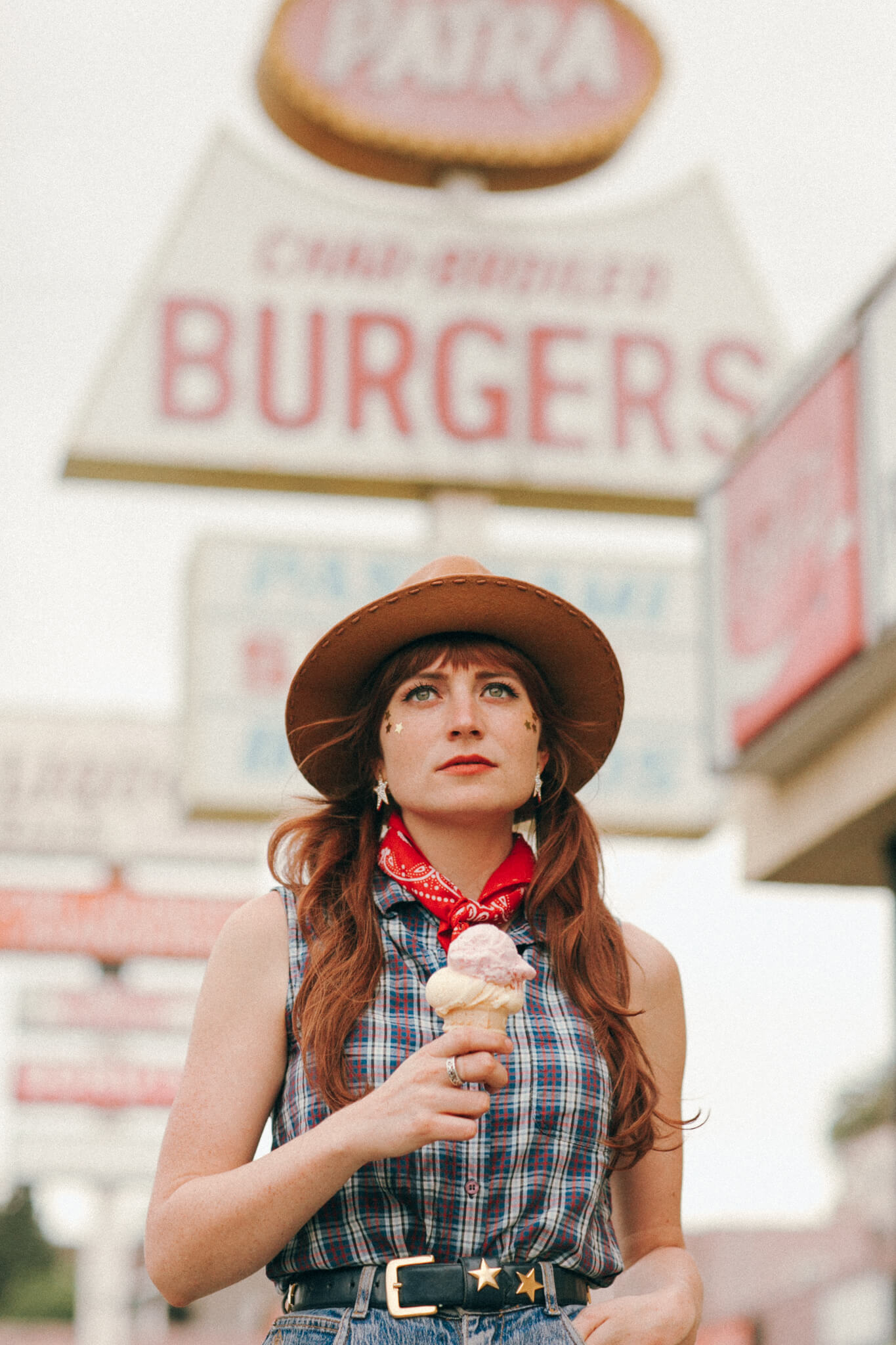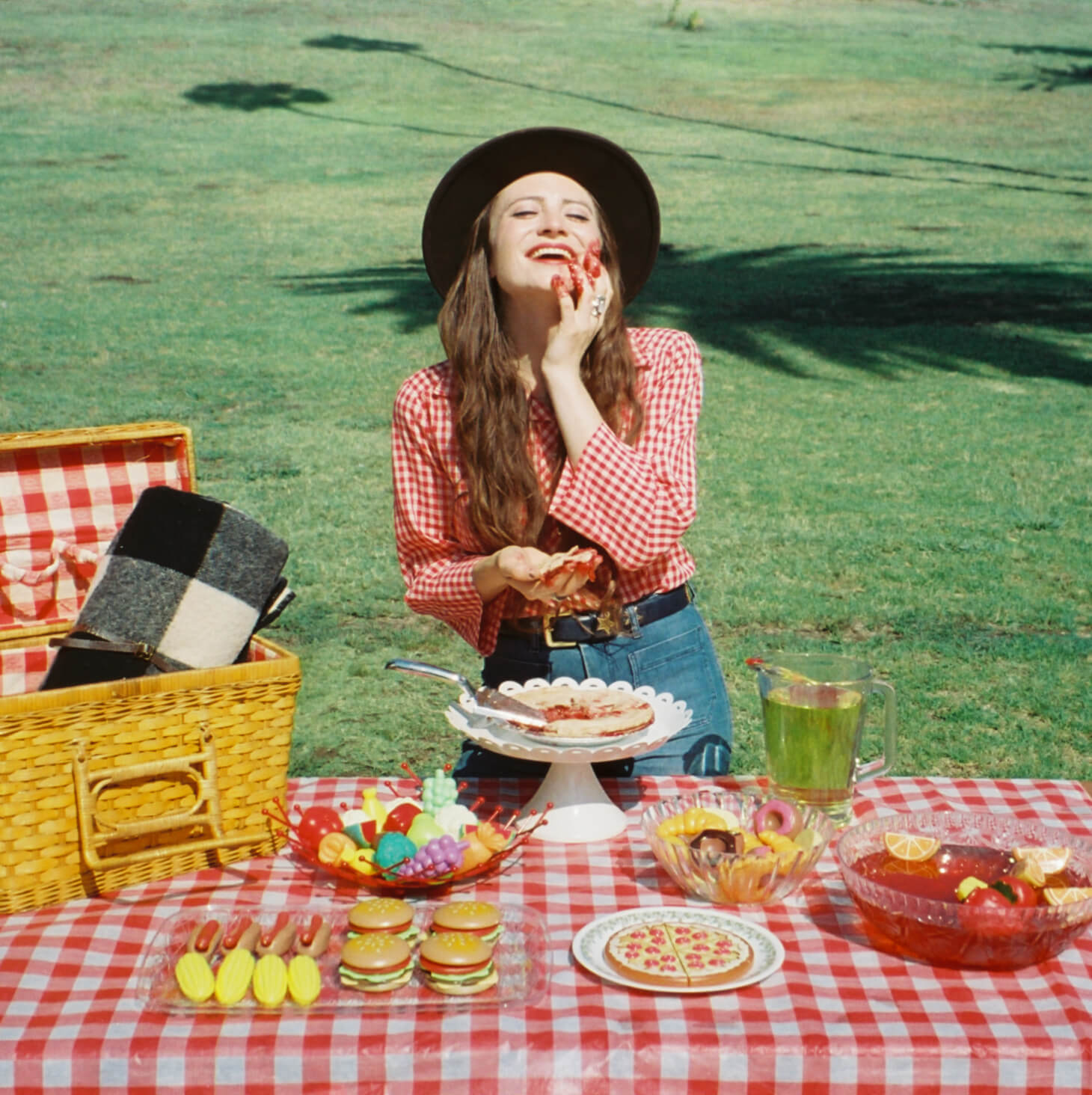On Dreams Past, Present, and Future: Interview with The Little Miss


When you listen to the music of The Little Miss–or Hayley Johnson, as she’s known off-stage–it can feel like you’ve entered a time warp to a “simpler” time. That time is somewhere near the middle of last century, and the location is somewhere in America, most likely a part where the stars shine real bright. But though the simple, twangy chord progressions and young Johnny Cash-style vocal tone evoke a real and immersive nostalgia–a feat that is impressive in and of itself–these old-fashioned elements aren’t the whole picture. Rather, they are the beloved, inherited antique picture-frame that showcases her lyrics, which are themselves a timely mirror for contemporary America.
The final track of her five-track EP, American Dream, is an acapella ballad called “Take Me, Too,” and it was released on Soundcloud on September 6. This week, Hayley was kind enough to tell us more about the EP, including the ideas behind it, what goes into her signature sound and imagery, and her perspective on how the aforementioned Dream manifests today.
How do you describe your sound to people who haven’t heard your music before?
I usually fumble through a description by saying, “Oh, well, it’s, uh… folksy, western-y, americana-y, singer-songwriter-y, country-type stuff.” If they still don’t understand (because I just rambled a bunch of nothing at them), then I say that’s it’s kind of like Johnny Cash meets Florence & The Machine. Perhaps I should just start with that…
What caused you to start thinking about the American Dream as a theme for your EP?
Contrary to how it may appear, I wrote these songs long before Trump was in office. But before Trump was even running for office, I’d argue, there’s been a rift in our society. He just happened to capitalize on it. Even still, as foolish as this may sound, I would like to believe that we all have more in common than not. I think that the powers that be have a lot to gain from us being divided, which is why fear-mongering is so prevalent. If we all hate each other and fear each other, then no one is going to talk to one another. That said, I wrote these songs with simple, universal themes in mind: life, liberty and the pursuit of happiness. Life is hard for everyone. If we embraced our shared humanity, then maybe we could all, collectively, hold said powers accountable and do what is right by everybody.
Do you find the American Dream comforting and idyllic, or is it something you’re trying to poke holes in?
I would say both. The romantic part of my brain that gets high on nostalgia loves The Andy Griffith Show-type painting of American culture. I can close my eyes, turn on a classic record and very easily be transported to a fictional life of front porches, sweet tea and gingham-clad everything. It’s incredibly comforting. But that’s also the problem: it’s fictional and, perhaps, a bit too comforting. It’s a dream. And in the same way that a good dream is difficult to wake up from, I think that it’s incredibly uncomfortable to want to wake up from our collective dream about what our society looks like. It’s difficult to want to look at what is bad or wrong – in society, in ourselves, etc. But it’s a necessary step in trying to enact change for the better. As uncomfortable as it may be, we need to stop pressing snooze and wake up to what our society actually looks like.

I’m curious about the cover art for the EP. What made it the right match for the music inside?
I wanted the cover art to be a caricature of what we deem to be “classically American.” There’s an overload of red and white gingham, a fake, plastic picnic – oh, and I’m also smashing pie onto my face. To put it gently, some of the ideals that we’ve held dear for generations could stand to be more substantial (much like the picnic). We throw around words like “freedom” and “power” and “pride” a lot without thinking about what those things mean. How real is this dream? In practical terms – not just buzzwords that get people riled up – what does freedom look like? I’m smearing pie on my face, as to have embraced these words without having observed my surroundings. On the cover, I’m high on this classic, romantic depiction of how I see our country. But if you look again, you’ll notice that there’s nothing to really dig into. The enthusiasm is superficial.
Your music obviously evokes early American folk or country music like that of Woody Guthrie or Johnny Cash. Did you listen to these or related artists growing up? If not, what else draws you to this kind of nostalgic Southern aesthetic?
These grand ideas I have of the old west likely came about as a result of the books I read growing up. They did a lot to stoke my imagination. In some ways, I like to think of it as a ‘past life’ thing, because otherwise, I don’t have that good of an explanation for it. I didn’t discover greats such as Woody or Johnny until later in college. I grew up listening to top 40, a single Boston record I owned, and a lot of Jewel. Formative years were spent listening to a blend of radio hits and just a couple of singer-songwriters. In some ways, I have no idea where the spirit of my music came from. To this day, I still don’t listen to as much folk as you’d probably think I do. I listen to a lot of catchy, indie pop, sad singer-songwriter music and classic, old jazz. Go figure.
How do you achieve your “old-fashioned” sound? Are you using older equipment, or is it all about the spirit?
In the past, I have used older equipment (it’s so fun). This record was recorded on modern gear, though. That said, the old time-y spirit is always there.
To me it sounds like the lyrics of “Take Me, Too” start out discouraged or tired but then gain confidence over the course of the song, especially when you sing, “I can’t hold back any more feeling.” I’m interested in hearing more about that thought process. What was the song a reaction to in your own life?
Most of my songs move that way. They start out by being a little deflated, confused, or frustrated and build understanding along the way. I understand my emotions the more I write. So, if I start out a song, such as “Take Me, Too,” feeling paralyzingly overwhelmed, I usually end up in a place of more clarity. The feeling isn’t gone, but now I at least understand it and can do something about it.
I wrote that song specifically after having just moved to Los Angeles. In choosing to pursue music, I knew how much of an uphill battle I had ahead of me, and I didn’t want to scale any of that mountain. I wanted to magically transport myself to the peak. I was missing the bigger point, of course, but it didn’t change how scared I was.

Who is the narrator in your songs? Is it always a version of yourself? Or do you feel like it’s someone else?
My favorite lyrics usually come out when I’m not thinking. If I think too hard, or try too hard, you can tell. The best things just spill out. I think they’re emotions that have been trapped in the back of my brain for too long. If I sit quietly for long enough, they make their way to the front and eventually pour out. In this way, it’s difficult to take “credit” for any of it. The Little Miss, in my mind, is my higher self, so in some way, the narrator and myself are the same person. In other ways, she’s something I tap into. To answer your question, it’s a version of myself, but it doesn’t feel too far from who I am, either.
What’s next? Are you planning any tours, or creating anything new that you care to share a preview of?
Ooo yes! For the first time, I’m recording music *with* my band. In the past, I had my songs produced without a band, so I’m incredibly excited about this. We plan on releasing pairs of songs as ‘digital 7s’ over the course of the next year that will ultimately culminate in a full LP. The first two songs are a bit meaner and grittier, and I like ‘em that way. Expect more slide guitar, more angst and more of that southern-y folk-rock thing that I can’t explain. “Baby, it’s October” and “Without a Trace” will be released in late October of this year.
*****
To learn more about The Little Miss, follow her on Instagram and Twitter, or like her on Facebook. Also be sure to check out her track, “American Dream,” which was featured in our July playlist.











Responses